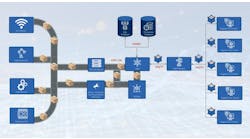The applications of artificial intelligence (AI) continue to expand, but it’s no surprise that low-code/no-code programming is at the forefront.
“Combining AI with low-code/no-code development accelerates digital transformation by enabling faster prototyping, broader accessibility and reducing the need for specialized coding skills,” says Lucas Oliveira, global account manager. downstream and chemicals, at Radix Engineering and Software (Figure 1). Oliveira is speaking on February 12 at the 29th Annual ARC Industry Leadership Forum in Orlando, Florida. “Integrating AI models into these platforms allows businesses to automate complex decisions, enhance user interactions with natural language processing and optimize workflows with intelligent recommendations.”
Get your subscription to Control Design’s daily newsletter.
Research from Mendix, a Siemens business, found that low-code platforms have become a strategic enabler supporting digital transformation at an organizational level. Siemens is a global sponsor of the ARC event.
“We have always believed that low-code had the potential to be much more than a tool to automate manual processes,” says Raymond Kok, CEO of Mendix (Figure 2). “This survey shows that the market agrees. Used wisely, low-code is about rethinking entire business processes from the ground up. In turn, this enables the other critical benefit of low-code: innovation. Enterprises will be able to speed up digital transformation cycles and innovate at scale. Low-code also opens new avenues for fusion teams to think bigger when it comes to using tech to transform their organization for the future, as long as they are prioritizing upskilling users to maximize the potential of low-code for their unique use cases. Low-code continues to be closely aligned to today’s market’s needs, while also offering a springboard for future innovation.”
With essential data locked in legacy systems for many manufacturing organizations, application development that digitizes operations is a valuable approach for the industry.
"Radix's Citizen Development empowers non-technical users to build robust applications, streamlining development processes and freeing developers to focus on higher-value tasks, driving efficiency and fostering large-scale innovation," says Oliveira.
Whether that’s improving quality control, streamlining processes, increasing customer satisfaction or improving employee safety, accelerating digital transformation is high on the agenda, with 52% of manufacturing IT leaders ranking digital transformation as their leading low-code use case.
“The Low-Code Perspective: Insights from Enterprise IT leaders” report provides an overview of the key trends shaping the low-code market among 2,000 global enterprise tech C-suite executives and senior IT decision-makers in the United States, Germany, United Kingdom, Japan Belgium, Netherlands and Luxembourg.
According to the report:
- 99% of manufacturing organizations surveyed are using low-code as part of their development process. Low-code is now a mainstream technology. For the majority of respondents (75%), low-code improves the organization’s ability to innovate at scale.
- 77% of respondents identify the C-suite as the driving force for low-code adoption. Low-code is seen as a strategic enterprise technology used to facilitate digital transformation and enhance operational efficiency. Long-term organization investment means the entire C-suite is now involved in low-code decision-making.
- A definitive 84% of manufacturing IT leaders surveyed say combining artificial intelligence and low-code would help the organization innovate faster, more than any other sector surveyed. Yet 69 % have concerns regarding the governance around AI-assisted coding. Survey results indicate that IT leaders want to invest in low-code and AI, but they acknowledge that functional implementation requires upskilling for both developers and non-technical users alike.
The highlights of low-code
The research shows that low-code development brings significant benefits to the enterprise. Respondents identified productivity as a core benefit, particularly for tech teams looking to meet lofty digital-transformation goals. The survey demonstrated a clear consensus that low-code increases productivity and helps organizations innovate faster at scale:
- 80% of survey respondents say that low-code improves productivity on technical teams
- 76% agree that low-code streamlines the development process
- 75% agree that low-code improves time to market
- 84 % agree that combining AI and low-code helps the organization innovate faster
- 75% agree that low-code enables development teams to innovate at scale.
Low-code: A top-down decision
According to the research, low-code has become a technology the entire C-suite advocates for. Half of manufacturing organizations state the chief operating officer (COO) and the chief executive officer (CEO) are both heavily involved in decision-making surrounding low-code adoption. The manufacturing industry actually reports the highest amount of CEO involvement of any sector surveyed.
Respondents are using low-code to digitally transform (52%), improve legacy processes (48%) and reduce operational costs (43% ).
More than three-fourths (77%) of the respondents stated that the C-suite sees low-code as the only option for coding in the future, as organizations need to manage costs as they innovate.
Educate and upskill for the best ROI
More than four-fifths (81%) of respondents are using low-code and AI-assisted coding, but while adoption is on the rise, AI-assisted development isn’t foolproof. For a majority of technical leaders, the need for further education for both developers and non-technical users will be key:
- 69% of technical leaders are concerned about the governance of AI-assisted coding
- 86% agree that more training needs to take place to ensure developers are using AI-assisted coding properly
- 82% agree that the C-suite understands they will need to upskill the technical staff to capitalize on the potential of low-code
- 70% agree the C-suite understands that they will need to upskill non-technical staff to create fusion teams that capitalize on the potential of low-code.
Yet, most senior IT decision-makers agree that low-code platforms work in partnership with their organizations to reduce risk and are adapting to the governance of low-code:
- 68% agree that low-code reduces risk / increases compliance with the latest regulations
- 42% of respondents ranked governance and security as one of their three defining criteria for vetting a low-code platform. However, deployment options are an important factor for those in manufacturing (37%), higher than any other sector surveyed.







